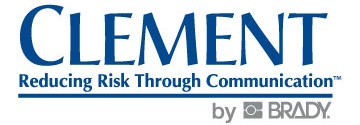When It Comes to Safety Solutions, Clement Has Always Had Your Back!
In 2019, Clement Communications celebrated our 100 year anniversary. We continue to be committed to helping companies:
- Build awareness of safety issues in the workplace
- Educate employees about safety hazards and safe work practices
- Motivate employees to take personal responsibility for their safety and that of their co-workers
Whether it’s through our best-selling programs or ones that we create specifically for your organization, our team of safety management and compliance experts is dedicated to helping you improve your employee communication program and reduce the risk of accidents and injuries in your workplace.
We develop and market programs for all levels of management to educate and motivate employees, promote safe attitudes and reinforce safe procedures in a positive way using print, electronic and web-based products.
Thanks to the vision, foresight and innovative ideas of our employees, we continue to be the premier provider of safety programs and tools for all business and government communities.
We consider the adherence to the highest ethical standards of conduct our greatest governing parameter in our pursuit of these goals.
Our History...
Since 1919, Clement Communications has helped employers motivate employees and change behavior to create a safer workplace.
In the turbulent aftermath of World War I, America’s political and business leaders were gravely concerned about the threat posed by these radical trends. George Y. “Bill” Clement, whose American Educational Services company was a pioneer in the emergent business-to-consumer communication industry, envisioned a solution. Recognizing that thousands of America’s workers were recent immigrants living in a free enterprise system for the first time, he set out to establish a platform for companies to engage in a positive dialogue with their employees about important business and social issues of the day.
His idea was to create Letters From Bill, an employer-sponsored weekly letter, going directly to employees’ homes and explaining the virtues of freedom, democracy, and America’s boundless opportunities for those with initiative, conscientious work habits and the willingness to “get onboard and get ahead.”
Our willingness to change and adapt to the needs of our customers as well as the unselfish dedication of a highly talented, diverse work force has allowed us to achieve sustained, profitable growth. Letters from Bill was an immediate hit and was soon distributed to over 100,000 employees of major industrial companies nationwide. These recipients typically shared their Letters with family and friends. A companion publication titled You and I, and The Other Fellow soon launched, which expanded on the ideals of America’s unique blend of individual rights and citizenship responsibilities.
In the 1930s, following the Depression, the company specialized in business-to-consumer communication programs for the banking industry, which had a significant challenge in re-establishing its bond of trust with the public at large. Clement’s American Institute of Publicity division spearheaded a nationwide effort to rebuild confidence in the banking system and re-educate everyone about the enduring values of sensible savings. Noteworthy in these efforts was the establishment of National Thrift Day, which was actively supported by civic and school leaders nationwide.
During the 1940s, Clement Communications created its first series of industrial workplace posters, which focused on safety awareness and proper work procedures for mining workers. The effectiveness of this premier poster program set the stage for the company’s role in helping America’s manufacturers meet their urgent World War II production goals. Companies often worked around the clock and employees commonly put in fatiguing extended shifts, heightening the need to perform each task smartly and safely, with a premium on cooperation and teamwork. The bold, high-spirited motivational posters produced by Clement were a signature feature of workplaces across the country. Clement’s poster programs continued to be effective in the postwar industrial environment, expanding into such areas as transportation, chemicals, food processing, energy and heavy manufacturing.
During the 1970-80s, an idea came to take employer-employee communications up to a new level altogether: Jim Unger’s widely syndicated Herman® comic strip was adapted to Clement’s Herman Workplace Posters in 1981 and instantly won the hearts of employees and managers alike. Partly as a reflection of the growing informality of society in general, and perhaps also because there’s a little bit of Herman in each of us, the humor and poignancy of these posters broke through in a refreshing and memorable way — and are still widely utilized in workplaces today.
In the 1990s, the company expanded to include 25 poster programs and a dozen newsletters. Reflecting the increased complexity of the modern workplace as well as ongoing expansion of OSHA regulations, safety and risk prevention became the key focus of many of these communication tools. The newsletter, Safety and the Supervisor, was created to address the safety concerns within the workplace. Human Resources also came to the forefront with the The Lawful Workplace and Smart Supervision newsletter and support tools.
In the 2000s, the business began to address the issues within specific industries including food processing, transportation, chemicals, schools and healthcare which included addressing issues of various regulatory groups within the government. OSHA continued to develop a stronger presence in the workplace and two additional newsletters were developed to address these concerns: Supervisor's Guide to OSHA focused on general industry and Foreman's Guide to OSHA focused on the construction industry. The company also moved toward personalizing current subscriptions by adding subscribers company logo. Clement also began creating customized content for our major customers which included doing photo shoots onsite at customer facilities. Customers wanted to show their employees doing the work safely as a way to reinforce thier safety message.
